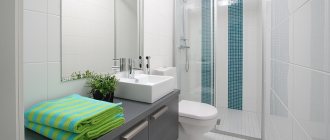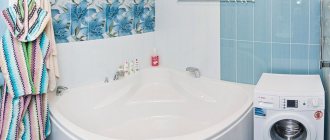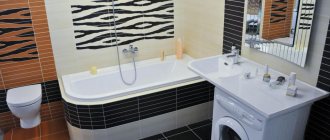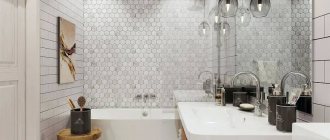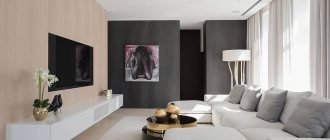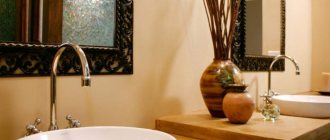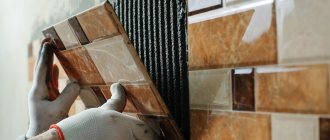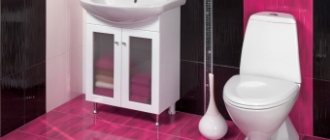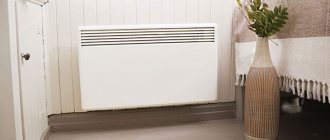One of the significant disadvantages of Khrushchev apartments is the small area of the rooms, and the bathroom is no exception. Often this room can only accommodate a bathtub and washbasin, leaving no room for other plumbing fixtures. To solve this problem, you will need to renovate the bathroom in the Khrushchev-era building.
View of a bathtub in a Khrushchev building after renovation.
The main problems of Khrushchev's construction
During the active construction of panel houses, the main goal was to quickly move people from barracks to apartments. Therefore, houses were built quickly, and the budget for the work was small. In Khrushchev's apartments there was a minimum of free space. The bathroom only contains a toilet, sink and bathtub. Today, such a layout does not meet the needs of residents, because the owners need to place a washing machine, shelves for cosmetics, a mirror, a heated towel rail and household chemicals.
The second problem is the state of engineering systems. Some of Khrushchev's buildings are already 60 years old, and the pipelines in the water supply and sewerage systems have fallen into disrepair. For modern plumbing fixtures, it is necessary to make new wiring, and for this you will have to carry out a major overhaul.
Problems in the bathroom.
The third problem is uneven walls. When installing pipes in a hidden manner, you will have to put in a lot of effort and time to level the surfaces.
The fourth problem is the inconvenient location of plumbing fixtures. To make a change, you will have to do additional wiring.
Possible redevelopment options
Before you begin remodeling a bathroom in a Khrushchev-era building, you must obtain official permission from the relevant authorities. You need to consult with a designer to develop possible redevelopment options. There are several ready-made ideas for placing items in the bathroom.
Bath layout.
Bath or shower
Based on your preferences and the area of the room, you can put a shower or bath in the bathroom.
Reasons why you should install a shower cabin:
- The smallest bathtub is 1.5 meters long, and the shower takes up half as much space on the floor.
- On average, 50 liters of water are spent on shower procedures, while in the bathroom - 3-4 times more. This affects the size of utility bills.
- If several people live in a house, it is unhygienic to wash in the same water. In this regard, the bathtub is significantly inferior to the shower stall.
The bath has the following advantages:
- The bathtub is easier to clean. You just need to pour in the powder, pour in water and let it sit. And in the case of a shower, you will have to use various products to clean the tray and glass.
- Taking a bath can be more relaxing than taking a shower.
- If there are children in the house, it is easier to wash them in the bathroom than in the shower.
Bathroom in Khrushchev with toilet
If the apartment has a small bathroom and toilet, you can combine them. In this case, the bathroom area will expand due to the thickness of the dismantled wall and one passage into two zones.
Bathroom in the bathroom.
However, there are cases when it is better to refuse combination:
- If the family is large, you will have to wait your turn in the toilet when one of the family members is taking a bath.
- If the bathroom is adjacent to the kitchen, then the combination leads to unpleasant odors and noise from the drainage of water in the kitchen.
There are also cases when combining a bathroom and toilet is recommended:
- If the bathroom and toilet have small areas.
- If the house has a large bathroom and a small toilet. In this case, the toilet is moved to the bathroom, and the toilet is converted into a pantry or dressing room.
Place for installing a washing machine
Before choosing a location for the washing machine, you must carefully plan the placement of all other plumbing fixtures. It is recommended to purchase narrower models of washing machines, as they will be easier to place in a small bathroom.
Some owners of Khrushchev-era apartments install a sink on one side of the front door and a washing machine on the other. It can also be placed under the washbasin, only in this case the drain pipe will have to be hidden behind the lining.
Washing machine in the bathroom.
Types of utility wiring
Before designing the wiring, you should become familiar with what types of such structures exist. There are only three of them. Moreover, one, with pass-through sockets, is practically not used. Therefore, we will not consider it.
Type #1. Serial type wiring
To implement this, taps are made from the cold and hot water supply risers leading to the first consumer. Pipes are laid from it to the second and further. Each water collection point is equipped with a tee, to one of the outlets of which the consumer is connected.
Overall this is a very simple scheme. It can only be used where the number of water consumers is small.
This is due to the fact that if several water collection points are activated simultaneously, the pressure in them will weaken and may be insufficient for the correct operation of the equipment. This is the main disadvantage of series wiring.
Image gallery
Photo from
Assembling the system using tees
Simple and inexpensive type of construction
Combination of tee and collector circuits
Minimum set of fittings
However, for apartments with one bathroom and a small amount of plumbing used, this may be the best option. A significant drawback of the system is the inability to turn off one of the plumbing fixtures for replacement or repair.
Serial wiring is extremely simple to implement, but not very convenient to use. However, for small bathrooms this solution may be quite acceptable.
There are many more advantages to sequential wiring. First of all, it is simplicity in design and installation. There will be no complex schemes here, everything is done very simply.
In addition, such wiring is considered the most economical option. The consumption of pipes and other elements will be significantly lower than in other systems, and installation costs are also minimal.
Even a novice plumber can handle the design and subsequent installation of sequential, otherwise tee, wiring
Type #2. Collector type of wiring
The collector type scheme involves connecting each of the consumers to the main line. For this, a special element is used, which is called a collector - a device that distributes water flows.
In a more complex version, and this is best, each collector outlet is equipped with a shut-off valve. Collector-type wiring can be considered the most convenient option to use. There are several reasons for this.
Image gallery
Photo from
Parallel connection of devices
High consumption of pipes and fittings
Mostly hidden gasket
Collector water supply outlets
Firstly , the absence of pressure drops in the system. All consumers receive equally good water pressure, even if all water points operate simultaneously.
If the pressure in the system of an apartment or private house is too low for some reason, you can temporarily limit the water supply to one of the consumers, for example, to the toilet, thereby increasing the pressure for others.
The collector type of wiring is more convenient to use than the serial type. In this case, a separate line goes to each consumer, which guarantees no problems with pressure. However, such a system turns out to be more complex in design and installation.
Secondly , the ability to disconnect plumbing fixtures from the water supply if they need replacement or repair.
Thirdly , reliability. In fact, a single pipe goes to each consumer, without any connections or other elements. A leak can only appear in the collector area or near the device itself. Here it will be very easy to find. For this reason, pipes with manifold wiring can be safely installed using a hidden method.
Fourthly , ease of use. If there is a problem with a plumbing fixture and a leak appears, for example, at a faucet, you do not need to crawl under the sink. It is enough to close the shut-off valve on the manifold leading to the faulty device and wait for the specialists to arrive.
Even a woman or child unfamiliar with plumbing can do this. At the same time, all other equipment will work properly.
Professionals recommend using manifolds with shut-off valves for installation in water supply systems. With their help, if necessary, you can easily stop the water supply to a branch or plumbing fixture in need of repair.
However, collector wiring also has some disadvantages. First of all, it will cost the owner more than a sequential circuit. This is due to the fact that it will be necessary to lay a branch to each consumer. This will take a lot more material.
In addition, the installation of manifolds and shut-off valves will be required if the distributors are not equipped with them. And the circuit itself will be much more complicated than a sequential one.
Choosing finishing material
To decorate the walls of the bathroom, it is recommended to choose one of the following materials:
- Ceramic tile. This material is available in a variety of colors and with different patterns on the surface. The smallest tiles have a surface area of 225 square meters. cm, while the largest are 600 sq. cm. It is worth buying medium-sized tiles, approximately 400 square meters. cm, because tiles that are too small will make the room look cramped, and tiles that are too large will look rough.
- PVC panels. This material is inferior to ceramic tiles in terms of variety of shades, but its price is lower. PVC panels are easy to clean, are not afraid of moisture and are resistant to wear.
The ceiling of a bathroom in a Khrushchev-era building is often finished with the same materials as the walls, but for a special effect you can choose:
- Glossy films. This material visually expands the space due to its ability to reflect light.
- Drywall with aluminum frame. Allows you to organize spot lighting.
When choosing a material for finishing the ceiling, you should pay attention to moisture resistance.
Finishing the floor should begin after completing the work on laying the sewer systems. It is recommended to choose a material with a high anti-slip index.
Options:
- A natural stone. It has a high durability and looks unusual. But not all owners can afford this material due to its high cost.
- Agglomerate. Its characteristics are similar to ceramic tiles. This material can change shape under the influence of special heating tools.
Bathroom finishing material.
Ways to organize a drain in a shower stall
Despite the almost identical appearance - the walls and floor are tiled, some doors, homemade shower stalls have many options for internal structure. There really is plenty to choose from.
If you look from the outside, there is not much difference
Types of pallets
The simplest and most reliable option to make a waterproof floor in the shower stall is to install a ready-made tray. It can be installed on bricks or made from foam blocks. By “finished pallet” we mean two types: acrylic and enameled. Acrylic is lightweight and non-slip, but turns yellow over time. Enameled - not bad to use, but slippery when wet: you have to put a rubber mat on it. Another advantage of acrylic is that it doesn’t feel as cold.
If both options do not work, make a pallet from brick or monolithic concrete, which is then lined with tiles - regular floor tiles, or mosaics. This is a capital decision, but difficult to implement. If you decide to make a shower tray from tiles, and you live in an apartment building, you will need very good multi-layer waterproofing: so that there are no problems with neighbors below and on the sides. This does not mean that in a private house a shower cabin is made with your own hands without waterproofing. It’s just that if you mess up, you will suffer yourself.
Half finished brick shower tray
There is another option - an intermediate one. A “trough” of suitable dimensions is made from metal, and it is well treated with anti-corrosion materials. They are installed on a podium made of bricks or foam blocks (a drain is also needed), if necessary, they are lined with bricks on the outside, forming a side or a step. A mosaic is glued on the inside.
These are the options you usually choose from. There is also a device without a visible tray at all, and the drain can be made into the wall, but then in the entire bathroom it is necessary to raise the floor level and form a slope towards the drain.
Sizes and shape: choose
Now about the sizes of shower cabins and trays in particular:
- 70*70 cm is very small, it’s difficult even for a slender person to bend over, you constantly hit the walls;
- 80*80 cm - somewhat better, but still cramped;
- 90*90 cm - can be considered optimal for a person of average size;
- 100 cm or more - you already feel normal, you can sit down without any problems.
Color scheme and style solutions
When arranging a bathroom, you must remember that light colors visually increase the space. In many cases, preference should be given to shades of white, beige, pink and bright green.
Styles that will make your bathroom unusual:
- Oriental. The cladding of walls, floors and ceilings is made mainly of tiles. In this case, preference is given to materials in gold, yellow and lilac shades. It is allowed to decorate the room with homemade elements made in oriental style: knitted rugs, jugs and vases.
- Japanese. A combination of red or white with black, pink with lilac and the presence of mint shades. The room is often decorated with orchids. Elements of Japanese symbols can be applied to the walls.
- Modern. Suitable for spacious bathrooms, since this style involves placing the bath in the middle of the room, as well as zoning the space, which cannot be done in a small room.
- Minimalism. Another style that is only suitable for spacious rooms. The walls are decorated with small mosaic tiles in beige shades. Minimalism does not tolerate the presence of a large number of elements in the room; even coat hooks are hidden behind the panel.
Design and color scheme in the bathroom.
Lighting
One of the most important stages in creating a bathroom design in an ordinary Khrushchev is the organization of lighting. Not only the overall appearance and aesthetics of the room, but also its proportions depend on how the light sources are located.
A popular solution is spotlights. They can be grouped in the center or illuminate each functional area in the bathroom.
The mirror is often complemented by symmetrical sconces. This placement promotes even distribution of light without shadows.
Furniture lighting installed inside a cabinet or floor lighting will look unusual. To do this, the floor is equipped with sealed and durable lamps or moisture-resistant colored light bulbs.
Preparation for repair
Preparatory work should begin with planning and creating a sketch of the room. The drawing should show the location of the bathtub, sink, toilet, bidet, cabinet, washing machine, shower cabin, as well as the placement of all elements of utilities: water meters, sewer pipes, power supply systems, etc. Based on the diagram, you need to make a list of necessary materials and tools. With the right approach to repairs, all work can be done with your own hands.
Removing an old bathtub and sink
After completing the preparatory stage, you can begin dismantling the old sink and bathtub. Removing the bathtub is more difficult, since during the Soviet period they were made of cast iron.
The following recommendations must be followed during dismantling:
- The cast iron siphon with which the bathtub is connected to the sewer cannot be unscrewed. It is better to carefully cut it with a grinder.
- Old bathtubs in Khrushchev-era buildings often grow together with the surrounding thick tiles due to the cement and salts that are constantly deposited there. To move such a bathtub from its place, it is necessary to knock down the tiles.
- It will not be possible to carry out the dismantled bathtub alone, because its width is larger than the doorway. Therefore, first they take out the front pair of legs of the bathtub, wrap it behind the doorway, and then take out the back pair.
Removing old wall and ceiling coverings
In old bathrooms, the walls and ceilings are whitewashed with lime mortar. The whitewash is removed with a spatula, but it must first be moistened with a spray, as dust is released during cleaning. It is recommended to moisten the surface with water every 10 minutes.
Preparing for a bathroom renovation.
↑ Room cladding
Again, in the evening I primed all the walls and the screen under the bathroom with Ceresit ST19 primer-paint. When working with it, I strongly recommend that you carefully cover the bathtub with an old blanket or sheet and immediately wipe off the primer if it gets on the enamel or tiles - it will be too difficult to remove it later, after it has dried.
At the stage of preparatory work, I compiled a layout of tiles from the collections Keramin “Manhattan” and the Italian Alta Ceramica (collection “La Petra di Volta”. The apron in the kitchen was laid with Italian tiles and we are delighted with it.
The tiling of the bathroom took two and a half working days. The most difficult job was in the diagonal laying of Italian tiles, but our tiler successfully completed the task.
Ultimately, the niche was made not dark, as in the layout diagram, but light. The frame already shows a new Wassercraft faucet with a short spout, located not at the end of the bathtub, as usual, but on the side, so that it is convenient to regulate the flow of water without getting up from the bathtub.
And here is the shelf above the front door, already tiled. Made from two sheets of thin plasterboard (6mm) screwed with self-tapping screws to a wooden frame (boards 100x18 mm). Basins and containers with clean towels are now stored on this shelf.
The wiring for the fan and hanging cabinet was pre-installed.
Well, that’s how it happened somehow. Upon completion of the work, even the skeptical uncle of the wife melted - he really liked the result of our idea and his work. On the right under the bathroom there is space for access to communications.
Replacement of pipes and wiring
Replacement of electrical wiring should begin before finishing work begins, since channels will need to be made for the wires. It is recommended to purchase double sockets and place the switch outside the bathroom.
Pipelines can be laid using both closed and open methods, attaching them with clips. In Soviet times, only cast iron pipes were used, but it is recommended to replace them with plastic ones, since the latter are easier to install and are not inferior in strength to cast iron.
Working with ceramic tiles
For finishing work, you need a building level and a plumb line, with the help of which lines are drawn on the surface for the correct laying of tiles. The glue is applied in a thin layer only to the area of the surface on which the tiles will now be laid. Then you need to lightly press it against the wall.
Tiled bathroom.
How to choose plumbing
If the choice was made in favor of a bathtub, then it is better to purchase a corner option, this way you can save a lot of space. It is recommended to install a glass sink - these models have a bowl-shaped shape, which allows you to place a washing machine next to it.
If you don’t want to install a glass washbasin, then you can install a ceramic one and hide the wiring behind the wall. A washing machine is installed in the vacant space.
Plumbing in the bathroom.
Shower doors
If the cabin is rectangular, everything is solved more or less simply: the rectangle can be cut out of glass in the workshop. There are many canopies for glass doors, you can choose the one that is more convenient for your case. Just order doors with canopies: you will have to drill holes for them, and it is best to try them on.
It is advisable to take tempered glass. Even if it breaks, it will be into small fragments with blunt edges that are difficult to injure. But, most likely, the fragments will remain hanging on the film. The downside of this glass is that it is expensive. To save money, you can order a regular thick one - 5-6 mm, and at home cover it on both sides with a translucent polymer film. You will have to tinker, but the effect will be almost the same as with tempered glass: the fragments will be on the film.
The simplest, but most expensive option is to install glass doors in a homemade shower stall
One point: the glass is washed before applying the film, then degreased. The film is glued to wet glass. This makes it easier to expel air bubbles, and you can also move the film for a while.
If you don’t want glass doors, but need translucent ones, you can make them from polycarbonate, but not cellular, but sheet. You will have to find a suitable furniture profile, make a frame out of it, and put polycarbonate into the frame with sealant. For reliability, you can also attach it through with screws and washers.
Another option is to buy ready-made doors. There are also glass ones specifically for cabins, or you can use plastic folding “accordion” ones, as in the video.
Some design tricks
If the room area is small, it is recommended to install a corner bath and place the washing machine under the washbasin.
The following design ideas will make your bathroom bright and airy:
- Install a heated towel rail instead of a radiator.
- Place a cabinet for household chemicals in the space under the bathroom.
- Finish the walls and ceiling with glossy material, which will visually expand the space.
- Install a toilet with installation. This design looks compact and can withstand weight up to 200 kg.
Any design solution in Khrushchev-era bathrooms is aimed at wisely using free space and creating the visual effect of increasing space.
Features of the room
Bathrooms in Khrushchev buildings have a small area : 3 m² if it is a combined bathroom, and 2 m² if the toilet is located in a separate room. Also, Khrushchev-era buildings often have very crooked walls that require high-quality leveling. Sometimes the rooms have an irregular shape.
Another common problem is lack of ventilation , which, combined with humid air in the room itself, creates an environment attractive to fungus and mold.
It is clear that in such conditions there is no question of design solutions based on complex shapes and detailed finishing. Not only will this not be practical, but it will also most likely look cheap in a cramped space.
It would be much better to opt for a simple minimalist design in light colors with rational use of the available space.

